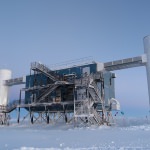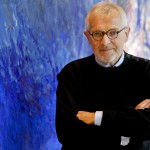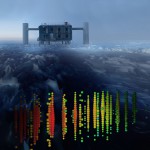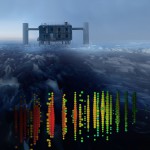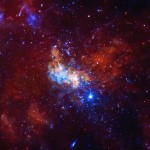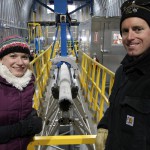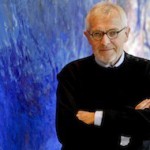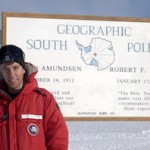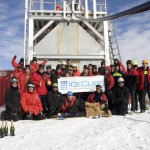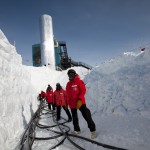Tag IceCube
Balzan Prize goes to UW neutrino pioneer
Francis Halzen, the University of Wisconsin–Madison physicist and leader of the giant neutrino telescope known as IceCube, has been named winner of a 2015 Balzan Prize.
Boundless Together: The research behind the commercial
A new commercial for UW–Madison will premier during the season-opening Badger football game on Aug. 5. Learn more about the cutting-edge research highlighted in the spot.
New data from Antarctic detector firms up cosmic neutrino sighting
Researchers using the IceCube Neutrino Observatory have sorted through the billions of subatomic particles that zip through its frozen cubic-kilometer-sized detector each year to gather powerful new evidence in support of 2013 observations confirming the existence of cosmic neutrinos.
Telescopes hint at neutrino beacon at the heart of the Milky Way
Thanks to a confluence of data from a suite of vastly different telescopes, there are tantalizing clues that the massive black hole at the core of the Milky Way may be a cosmic accelerator. In a recent paper published in the journal Physical Review D, a team led by University of Wisconsin–Madison physicist Yang Bai reports a correlation of IceCube data with a recorded burst of X-rays from Sagittarius A, an object at the center of our galaxy that is believed to be a supermassive black hole.
They know the drill: UW leads the league in boring through ice sheets
Hollow coring drills designed and managed by UW–Madison’s Ice Drilling Design and Operations (IDDO) program are used to extract ice cores that can analyze the past atmosphere. Shaun Marcott, an assistant professor of geoscience at UW–Madison, was the first author of a paper published today in the journal Nature documenting carbon dioxide in the atmosphere between 23,000 and 9,000 years ago, based on data from an 11,000-foot hole in Antarctica.
UW physicist receives American Ingenuity Award for IceCube effort
Francis Halzen, the University of Wisconsin–Madison physicist who was the driving force behind the giant neutrino telescope known as IceCube at the South Pole, has been named a winner of the 2014 American Ingenuity Award.
Nathan Whitehorn a 2014 ‘Young Star’ in astrophysics
Nathan Whitehorn, a postdoctoral researcher on the IceCube project at the University of Wisconsin–Madison, has been named a “Young Star” by the Division of Astrophysics of the American Physical Society (APS).
IceCube named 2013 Breakthrough of the Year for neutrino discovery
Less than one month after reporting the first evidence for cosmic neutrinos, the IceCube project received the 2013 Breakthrough of the Year award from the British magazine Physics World.
IceCube feature film to premiere in Milwaukee planetarium show
The IceCube Neutrino Observatory is one of a kind. Built deep within the Antarctic ice, it is the world’s largest neutrino detector. Now, thanks to a collaboration between the Wisconsin IceCube Particle Astrophysics Center (WIPAC) and the Milwaukee Public Museum, it boasts another unique aspect: its own planetarium show.
Improved computing provides a better look at the cosmos
Building a neutrino telescope - a unique instrument that detects extremely small, high energy particles - out of 5,000 optical sensors embedded in a cubic kilometer of Antarctic ice, a tremendous engineering feat, was just the first challenge.
IceCube Neutrino Observatory reports first evidence for extraterrestrial high-energy neutrinos
A massive telescope in the Antarctic ice reports the detection of 28 extremely high-energy neutrinos that might have their origin in cosmic sources. Two of these reached energies greater than 1 petaelectronvolt (PeV), an energy level thousands of times higher than the highest energy neutrino yet produced in a manmade accelerator.
Experience the South Pole in Madison with an exploration of sound, light and images
Deep in the Antarctic ice, more than 5,000 detector modules sit in frozen darkness, waiting for the blue bursts of radiation released by particle interactions. Optimized to detect signs of neutrinos - tiny, nearly massless particles that can travel from the edges of the universe - these basketball-sized detectors comprise the IceCube Neutrino Observatory, one of the biggest astrophysics projects in the world.
International astrophysics reaches Milwaukee
Trips to the South Pole usually require a lot of specialized equipment, but Nils Irland's packing list for his November 2012 visit included some items unusual even by those standards: a specially designed video camera, extra batteries, and lots and lots of data storage.
‘Bringing the Universe to Wisconsin’ begins at UW–River Falls
It took seven years and the efforts of an international collaboration of scientists to turn the South Pole ice into the world's largest, most innovative telescope: the IceCube Neutrino Observatory.

